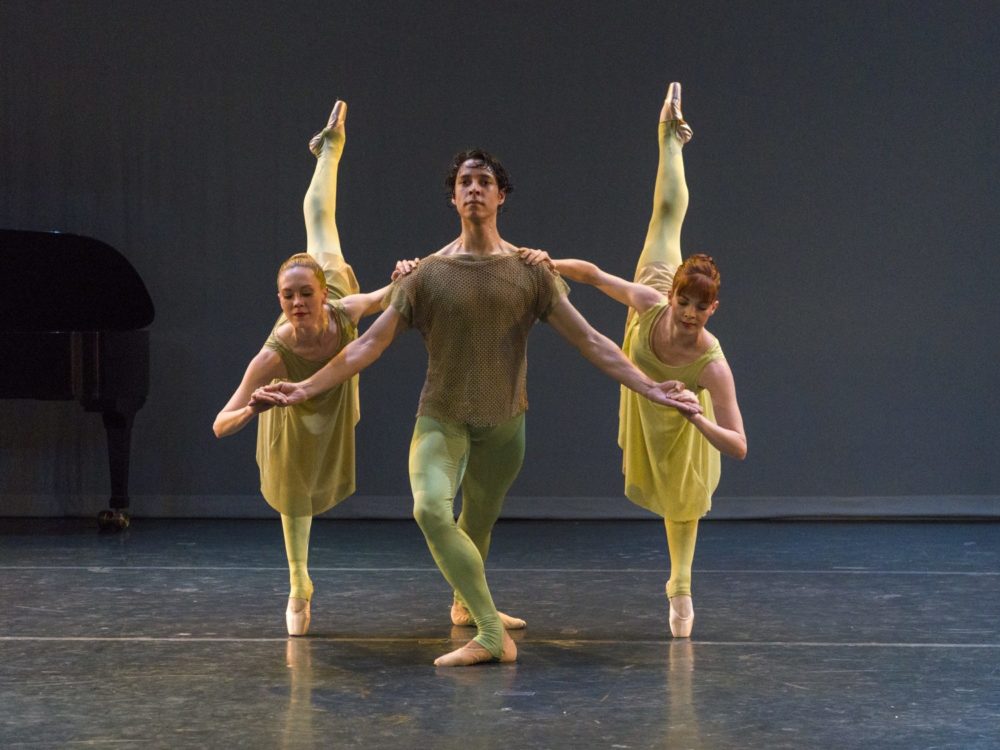Only the work of Merce Cunningham can make someone feel they have travelled decades through time in one evening, as New York Theatre Ballet’s REP program at Danspace was an evening celebration of one of the most innovative modern dance masters of all time. Although honorary 100th birthday performances have been happening globally for this modern dance legend, NYTB definitely cracked open the Merce Cunningham pinata with this diverse selection of timeless repertory.
The company began the journey through time with Scramble, which ironically was very experimental and emergent for its original time period in terms of music and abstraction. When seeing it in person, you’re somehow both in the future and past, as the dancers in their colourful variety of old fashioned unitards began performing silent individual phrases leading up to athletic and reactive partner work, the shifting around of the large iconic abstract colours in the stage set, and the early John Cage music setting an ominous tone. As a prominent trait of Cunningham’s work, the dancers filled the entire space, showing off scrambling power struggle of colors and Cunningham technique at it’s most actualized. It was a treat to see one of his most classic pieces at the forefront as aphoristic attitudes, arabesques, and beautiful partner lifts arising out of the colourful concoction were performed with all of the intensity and accented detail required for this composition.
Known for his unpredictability, Merce specializes in dynamics and useful repetitions as choreographic devices; just when you think one thing is about to happen, there is a spring of something different or disruptive in a very gratifying way. His choreography pays attention to detail, and you must as well as movements, normally just one dancer, will only repeat themselves for moments of resurfacing before dissolving into an array of jumping dancers before somehow the entire piece ends in a unison phrase resulting in simplicity and silence, just as it began.

Seasons, a work by Richard Alston as he sets forth as NYTB’s new resident choreographer, was clearly choreographically influenced by Cunningham’s but without the executed impact. The work began Cunningham style with dancers overlaying phrases, some moving in place with others traveling through space yet filling the entire space with pauses and stillness finally settling before the John Cage music intervened. The dancers all wore a mixture of green, blue, and yellow with differentiation in textures and design, adding a light whimsical feel that lasted throughout the piece. It was hard to actually discern the seasons other than the ambiguous section of music that played during the winter portion. As the theme of seasons is always relatable to a wide audience, it lacked curiosity and innovation as it became a predictable story of the weather, which may very well be the cup of tea for many.
The performance took an abrupt turn into the delightful and humorous in William Strunk Jr. and E.B. White’s The Elements of Style showing off the piano skills while we got to see dancers act while they put on the charm along with all of the fancy clothing. Use of side lighting set the environment as a jazzy club while the dancers moved to the music in a satisfying way with romantic grandiose lifts and moments of laughter among the audience.
In this musical theatre satire, the dancers are activated by the live narrator as a simple yet informative story of elegance, style, clarity, and other themes are stated as matter of fact. This period piece comprises of soft shoe shuffling, balletic bursts of movement in high heels, poses in poise, and theatrical interactions all surrounding a gregarious Dirk Lumbard reciting the seven rules of good writing we all held in our programs. An idiosyncratic inspiration for a dance work could be your first thought, but at the end of the whirls of fun character playing of the dancers and theatrical presentation, you are overcome with delight.
Reviewed at Danspace Project on 15th of March


